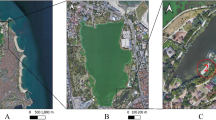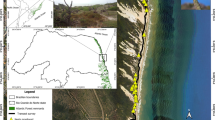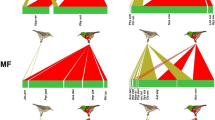Abstract
Females target elaborate secondary sexual traits to acquire either direct benefits, represented or provided by the trait, or indirect benefits usually in the form of genetic components. The link between a male’s trait and his potential genetic contribution is often unclear. Bowers are extreme examples of secondary sexual traits, built and decorated by males and targeted by females. However, why females should base their mate choice on such structures is unclear. One of the simplest suggestions is that bowers are sites where males exhibit collections of objects that are inherently highly costly, indicating male quality to the choosy female. Such costs can be imposed in two ways, acquisition from the local area, and maintenance in the face of degradation. We studied bowers of spotted bowerbirds Chlamydera maculata at three sites in central Queensland and tested whether components of the bowers that best predict mating success were some of the most costly in the local environment by measuring their abundance, physical dimensions and rate of decay. We also tested whether rare objects per se found on the bowers, were relatively good predictors of mating success. Finally, we experimentally tested whether males preferentially chose rare, and hence costly, objects to use as decorations. We found that objects used on bowers were not unusually costly. Specific objects identified as good predictors of mating success were also some of the more common objects found in the area. They were not the largest objects used on bowers and decayed slowly relative to other objects available for use as decorations. Rare objects in general were not good predictors of mating success and males did not prefer to use rare objects when offered choices. In conclusion, we found no support for the theory that by simply inspecting numbers of decorations and assessing their costs of acquisition and maintenance females can easily obtain information regarding the owner’s quality. This is due to the fact that decorations used by spotted bowerbirds are not inherently costly.





Similar content being viewed by others
References
Basolo A (1990) Female preference predates the evolution of the sword in swordtail fish. Science 250:808–810
Borgia G (1985) Bower quality, number of decorations and mating success of male satin bowerbirds (Ptilonorhynchus violaceus) - an experimental analysis. Anim Behav 33:266–271
Borgia G (1986) Sexual selection in bowerbirds. Sci Am 254:92–100
Borgia G (1993) The cost of display in the non-resource based mating system of the satin bowerbird. Am Nat 141:729–743
Borgia G (1995a) Complex male display and female choice in the spotted bowerbird—specialized functions for different bower decorations. Anim Behav 49:1291–1301
Borgia G (1995b) Threat reduction as a cause of differences in bower architecture, bower decoration and male display in two closely related bowerbirds Chlamydera nuchalis and C. maculata. Emu 95:1–12.
Borgia G (1996) Satin bowerbird displays are not extremely costly. Anim Behav 52:648–650
Borgia G, Gore MA (1986) Feather stealing in the satin bowerbird (Ptilonorhynchus violaceus) - male competition and the quality of display. Anim Behav 34:727–738
Borgia G, Mueller U (1992) Bower destruction, decoration stealing and female choice in the spotted bowerbird Chlamydera maculata. Emu 92:11–18
Borgia G, Presgraves DC (1998) Coevolution of elaborated male display traits in the spotted bowerbird: an experimental test of the threat reduction hypothesis. Anim Behav 56:1121–1128
Borgia G, Pruett-Jones S, Pruett-Jones M, (1985) Bowers as markers of male quality. Z Tierpsychol 67:225–236
Borgia G, Kaatz IM, Condit R (1987) Flower choice and bower decoration in the satin bowerbird Ptilonorhynchus violaceus: a test of hypotheses for the evolution of male display. Anim Behav 35:1129–1139
Brooks R, Kemp D (2001) Can older males deliver the good genes? Trends Ecol Evol 16:308–316.
Diamond J (1987) Bower building and decoration by the bowerbird Amblyornis inornatus. Ethology 74:177–204
Diamond J (1988). Experimental study of bower decoration by the bowerbird Amblyornis inornatus, using colored poker chips. Am Nat 131:631–653
Dukas (1999) Costs of memory: Ideas and predictions. J Theor Biol 197:41–50
Endler JA, Basolo AL (1998) Sensory ecology, receiver biases and sexual selection. Trends Ecol Evol 13:415–420
Frith CB, Frith DW (1990) Archbolds Bowerbird Archboldia papuensis (Ptilonorhynchidae) uses plumes from King of Saxony bird of paradise Pteridophora alberti (Paradisaeidae) as bower decoration. Emu 90:136–137
Frith CB, Frith DW (2004) Bowerbirds. Oxford University Press, Oxford (in press)
Hunter CP, Dwyer PD (1997) The value of objects to satin bowerbirds Ptilonorhynchus violaceus. Emu 97:200–206
Johnstone RA (1995) Sexual selection, honest advertisement and the handicap principle—reviewing the evidence. Biol Rev 70:1–65
Kokko H (2001) Fisherian and “good genes” benefits of mate choice: how (not) to distinguish between them. Ecol Lett 4:322–326.
Kotiaho JS (2001) Costs of sexual traits: a mismatch between theoretical considerations and emperical evidence. Biol Rev 76:365–376
Lenz N (1994) Mating behaviour and sexual competition in the Regent bowerbird Sericulus chrysocephalus. Emu 94:263–272
Madden J (2001) Sex, bowers and brains. Proc R Soc Lond B 268:833–838
Madden JR (2002) Bower decorations attract females but provoke other male spotted bowerbirds – bower owners resolve this trade off. Proc R Soc Lond B 269:1347–1352
Madden JR (2003a) Bower decorations are good predictors of mating success in the spotted bowerbird. Behav Ecol Sociobiol 53:269–277
Madden JR (2003b) Male spotted bowerbirds preferentially choose, arrange and proffer objects that are good predictors of mating success. Behav Ecol Sociobiol 53:263–268
Madden JR, Tanner K (2003) Preferences for coloured bower decorations can be explained in a non-sexual context. Anim Behav 65:1077–1083
Marshall AJ (1954) Bowerbirds: their display and breeding cycle. Oxford University Press, Oxford
Maxwell PS (1999) Learning in immature male satin bowerbirds (Ptilonorhynchus violaceus). BSc Dissertation, University of Queensland, Brisbane
Maynard Smith J (1991) Theories of sexual selection. Trends Ecol Evol 6:146–151
Miles AJ, Madden JR (2002) Bower location by the spotted bowerbird Chlamydera maculata. Emu 102:187–193
Milson J (1995) Plant identification in the arid zone. Department of Primary Industries, Brisbane, Australia
Pagel MD, Trevelyan R, Harvey P (1988) The evolution of bowerbuilding. Trends Ecol Evol 11:288–290
Pruett-Jones M, Pruett-Jones S (1994) Sexual competition and courtship disruptions: why do male bowerbirds destroy each others bowers? Anim Behav 47:607–620
Rice WR (1989) Analysing tables of statistical tests. Evolution 43:223–225
Ryan MJ, Fox JH, Wilczynski W, Rand AS (1990) Sexual selection for sensory exploitation in the frog Physalaemus pustulosus. Nature 343:66–67
Sheldon BC (1996) Are bowerbird displays cheap? Anim Behav 52:645–647
Uy JAC, Borgia G (2000) Sexual selection drives rapid divergence in bowerbird display traits. Evolution 54:273–278
Vellenga R (1986) Bower-building behaviour of immature satin bowerbirds Ptilonorhynchus violaceus. Aust Bird Watch 11:166–167
Acknowledgements
We thank the Queensland Parks and Wildlife Service for access to Taunton NP (Scientific); Michael Jefferies and the Department of Primary Industry, Queensland, for access to Brigalow; the McCullough family and Cliff and Dawn Frith for access to Bruslee. Birds were banded under the authority of the Australian Bird and Bat Banding Scheme. The work was approved by the James Cook University ethics committee. G. Anelay, R. Coe, D. Harris, G. Madgewick, A. Miles, K. Moore, K. Munro, M. McCullough, N. Ockendon, L. Pitt, G. Porter, R. Sawle and M. Whitby helped in measuring bowers, conducting transects and running the experiment. John Endler, Rufus Johnstone and three anonymous referees provided helpful comments on the manuscript. J.R.M. was supported by a NERC studentship and the Royal Society provided funding for A.B.
Author information
Authors and Affiliations
Corresponding author
Additional information
Communicated by J. Graves
Rights and permissions
About this article
Cite this article
Madden, J.R., Balmford, A. Spotted bowerbirds Chlamydera maculata do not prefer rare or costly bower decorations. Behav Ecol Sociobiol 55, 589–595 (2004). https://doi.org/10.1007/s00265-003-0737-6
Received:
Revised:
Accepted:
Published:
Issue Date:
DOI: https://doi.org/10.1007/s00265-003-0737-6




